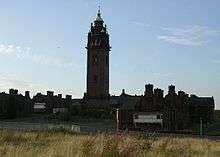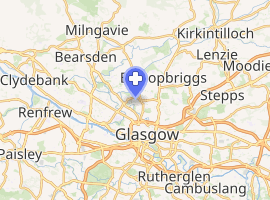Ruchill Hospital
Ruchill Hospital was an infectious diseases hospital in the Ruchill area of Glasgow, Scotland. The hospital was closed in 1998 and was sold to Scottish Enterprise in July 1999. It was managed by NHS Greater Glasgow.
| Ruchill Hospital | |
|---|---|
| NHS Greater Glasgow | |
 The remaining derelict buildings of Ruchill Hospital in 2005 | |

| |
 Shown in Glasgow | |
| Geography | |
| Location | Glasgow, Scotland |
| Coordinates | 55.8888°N 4.2640°W |
| Organisation | |
| Care system | NHS |
| Funding | Government, Public |
| Type | Specialist |
| Services | |
| Beds | 1,000 (1948) |
| Speciality | Infectious diseases |
| History | |
| Opened | 1900 |
| Closed | 1998 |
| Links | |
| Lists | Hospitals in Scotland |
History
In 1891 when the boundaries of Glasgow were extended to include Ruchill and Maryhill, the Glasgow Corporation purchased 53 acres (21 ha) of land there for a public park, golf course and 36 acres (15 ha) for the city's second fever hospital,[1] to create the additional capacity beyond that already provided at Belvidere Hospital in Parkhead.[2]
Ruchill Hospital was designed by the City Engineer, Alexander B. McDonald in a Neo Jacobean style, largely using red brick dressed with red sandstone ashlar.[3] McDonald was responsible for a number of civic projects in the city from 1890 to 1914, the most notable being the People's Palace.[4]
Work started on Ruchill Hospital on 16 April 1895, and the foundation stone was laid by Lady Bell, the wife of Sir James Bell, Lord Provost of Glasgow, on 29 August 1895. The hospital cost £250,000 and was designed to deal specifically with infectious diseases, such as smallpox, diphtheria, scarlet fever, poliomyelitis and measles, which were widespread at the time.[1] It was opened by Princess Christian on 13 June 1900.[5]
It had an initial capacity of 440 beds, spread across sixteen isolated Nightingale ward pavilions, twelve of which were large, each containing beds for 30 patients, and four smaller ones accommodating 20 patients each.[6] The only entrance was via a gatehouse on Bilsland Drive. Other buildings included a kitchen and stores block, an administration block, a clearing house (to direct patients to appropriate treatment locations), a mortuary and laboratory block, a stable block, a sanitary wash house and disinfecting station, a laundry and a three-storey nurses home as well as ten staff villas and semi-detached cottages along Bilsland Drive. The centrepiece however was its 165 ft (50 m) water tower, required due to the height of the site.[7]
In the early 20th century, an additional 270 beds were provided with the construction of three ward pavilions and a tuberculosis pavilion.[8]
By the time of its absorption into the National Health Service in 1948 Ruchill Hospital had 1,000 beds.[8] The first nude mice were discovered by Dr. Norman R. Grist at the newly-estblished Brownlee virology laboratory in the hospital in 1962.[9] With the discovery of vaccinations and improved public health, cases of diseases like tuberculosis declined, and the number of in-patients had reduced to 586 by 1975.[8]
Jessie McTavish, a nurse, was convicted of murdering a patient with insulin at the hospital in 1974.[10]
In addition to treating other sexually transmitted diseases, Ruchill Hospital was also designated the primary Glasgow hospital dealing with cases of HIV, the cause of AIDS, after the emergence of this virus, in the early 1980s. In addition, the Scottish Centre for Infection and Environmental Health, or SCIEH, the progenitor of today's Health Protection Scotland was based at the hospital.[11]
After the opening of the Brownlee Centre for Infectious and Communicable Diseases at Gartnavel General Hospital, Ruchill Hospital closed in 1998.[1]
The site was sold to Scottish Enterprise in July 1999.[1] Plans were subsequently submitted by Scottish Enterprise in April 2010 to demolish all the remaining listed buildings, with the exception of the red-brick category A-listed water tower.[7] This was rejected by Glasgow City Council's planning committee in April 2011. Scottish Enterprise appealed the decision and secured consent to proceed with the demolition in December 2012. Following the demolition of the other buildings, the hospital's red-brick water tower remains a particularly prominent local landmark.[3]
References
- McCall, Amanda. "Memories of Ruchill Hospital as demolition team moves in". STV News. Retrieved 11 September 2014.
- "Belvidere Hospital". Historic Hospitals. 2016-07-26. Retrieved 24 January 2019.
- "Ruchill Hospital Main Stairway". Buildings at Risk. Archived from the original on 11 September 2014. Retrieved 11 September 2014.
- "Alexander Beith McDonald". Dictionary of Scottish Architects. Retrieved 1 October 2014.
- "Ruchill Hospital". Historic Hospitals. 2015-04-26. Retrieved 24 January 2019.
- "Special Correspondence". British Medical Journal. NCBI. 1 (2060): 1562–1564. 1900. doi:10.1136/bmj.1.2060.1562. PMC 2506600.
- "520 Bilsland Drive, Ruchill Hospital, Water Tower". British Listed Buildings. Retrieved 24 January 2019.
- "Records of Ruchill Hospital, Glasgow, Scotland". Archives Hub. Retrieved 24 January 2019.
- "Nude Mice" (PDF). Archived from the original (PDF) on 2011-10-01. Retrieved 2013-06-08.
- "Nurse who inspired Colin Norris". The Telegraph. 2 March 2008. Retrieved 24 January 2019.
- "SCIEH Weekly newsletter 17 February 1998, Volume 32 No.98/07" (PDF). Health Protection Scotland. 17 February 1998. Retrieved 11 September 2014.